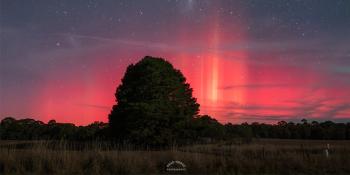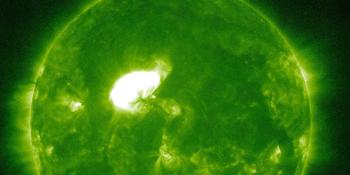Het archief bekijken van maandag 1 januari 2024
Dagelijks bulletin over zonne- en geomagnetische activiteit van het SIDC
Datum verslag: 2024 Jan 01 1234 UTC
SIDC Prognose
Zonnevlammen
M-class flares expected (probability >=50%)
Geomagnetisme
Active conditions expected (A>=20 or K=4)
Proton Flux monitor
Quiet
| 10cm flux | Ap | |
|---|---|---|
| 01 Jan 2024 | 146 | 012 |
| 02 Jan 2024 | 150 | 020 |
| 03 Jan 2024 | 155 | 010 |
Zonnevlekkengebieden en zonnevlammen
Solar flaring activity over the past 24 hours was at high levels, with one X-class flare and 2 M-class flares occurring. The largest flare was a X5.0-flare, with peak time 21:55 UTC on December 31, associated with NOAA AR 3536 (beta-gamma). A type IV radio emission was detected at 21:42 associated with this flare. Two M-class flares a M1.0-flare with peak time 19:12 UTC on December 31 and a M2.4-flare with peak time 09:13 UTC on January 01 were also associated with NOAA AR 3536 (beta-gamma). There are currently 4 numbered active regions on the visible disk. NOAA AR 3536 (beta-gamma) is a newly numbered active region that is currently rotating over the North-East limb, it is the most active and magnetically complex region on disk and has produced most of the flaring activity in the last 24 hours. It’s possible that this region is returning region NOAA 3514. NOAA AR 3534 (beta) has decreased in size and remained inactive. NOAA AR 3533 and NOAA AR 3534 were stable and inactive and have started to rotate over the west limb. The solar flaring activity is likely to be at moderate to high levels over the coming days with M-class flares expected and X-class flares possible.
Coronale massa uitstoten
A Coronal Mass Ejection (CME), was detected at 09:48 UTC on December 31, in LASCO C2 data. This CME is associated with a filament eruption, observed at 09:38 UTC on December 31, in SDO/AIA 304 and 193 in the north-west quadrant of the visible solar disk. A second CME was detected at 22:00 UTC on December 31, in LASCO C2 data. The CME is associated with a X5.0-flare, with peak time 21:55 UTC on December 31. A glancing blow from both these CMEs may be possible. Further analysis is ongoing.
Coronale gaten
The long negative polarity coronal hole has passed the central meridian. A second small high latitude coronal hole is passing the central meridian. No impact from this second small high latitude coronal hole is expected at Earth.
Zonnewind
Slow solar wind conditions were recorded over the past 24 hours. The interplanetary magnetic field fluctuated between 3 nT to 9 nT, with a minimum Bz value of -6 nT. The solar wind speed as fluctuated between 280 km/s and 338 km/s. The phi-angle was mainly in the negative sector (directed towards the Sun) with periods in the positive sector. The solar wind conditions in the next 24 hours are expected to registered disturbances due to expected high speed stream arrival later tonight. Disturbed conditions are expected to continue throughout Jan 2nd with a possible further enhancement on Jan 3rd subject to a minor glancing blow arrival from the partial halo CME on Dec 30th.
Geomagnetisme
The geomagnetic conditions over the past 24 hours were quiet globally (Kp 2+) and were quiet locally (K Bel 2). Quiet to active conditions are expected in the next 24 hours.
Proton flux niveaus
The greater than 10 MeV proton flux became enhanced and became further enhanced further after 23:00 UTC on December 31 but remains under the 10 pfu threshold over the past 24 hours. The enhancement was possibly associated with the X5.0-flare, with peak time 21:55 UTC on December 31.
Elektronenfluxen in geostationaire baan
The greater than 2 MeV GOES 16 electron flux was below the 1000 pfu threshold and is expected to remain so in the upcoming days. The 24h electron fluence was at nominal level and is expected to remain so in the next days.
Het geschatte internationale zonnevlekkengetal (ISN) van vandaag: 058, gebaseerd op 11 stations.Zon indexen voor 31 Dec 2023
| Wolfgetal Catania | /// |
| 10cm zonneflux | 146 |
| AK Chambon La Forêt | 005 |
| AK Wingst | 003 |
| Geschatte Ap | 003 |
| Geschat internationaal zonnevlekkengetal | 053 - Gebaseerd op 16 stations |
Overzicht opvallende gebeurtenissen
| Dag | Start | Max | Einde | Locatie | Sterkte | OP | 10cm | Catania/NOAA | Soorten radio-uitbarstingen |
|---|---|---|---|---|---|---|---|---|---|
| 31 | 1844 | 1912 | 1940 | ---- | M1.0 | --/3536 |
Aangeboden door het Solar Influences Data Analysis Center© - SIDC - Verwerkt door SpaceWeatherLive
Alle tijden in UTC
<< Keer terug naar de dagelijkse overview pagina
Laatste nieuws
Laatste forumberichten
Steun Poollicht.be!
Veel mensen komen naar Poollicht.be om de zonneactiviteit te volgen of om het poollicht te zien, maar met meer bezoekers komen er hogere kosten bij om de servers online te houden. Als je Poollicht.be leuk vindt en het project wilt steunen, kun je kiezen voor een abonnement op een advertentievrije website of een donatie overwegen. Met jouw hulp kunnen we Poollicht. be online houden!
Laatste alerts
Ruimteweer feitjes
| Laatste X-klasse uitbarsting | 19/06/2025 | X1.9 |
| Laatste M-klasse uitbarsting | 12/08/2025 | M1.8 |
| Laatste geomagnetische storm | 09/08/2025 | Kp6 (G2) |
| Zonnevlekkenloze dagen | |
|---|---|
| Laatste zonnevlekkenloze dag | 08/06/2022 |
| Maandelijks gemiddeld zonnevlekkengetal | |
|---|---|
| juli 2025 | 125.6 +9.3 |
| augustus 2025 | 140.3 +14.7 |
| Afgelopen 30 dagen | 137.9 +31.3 |





